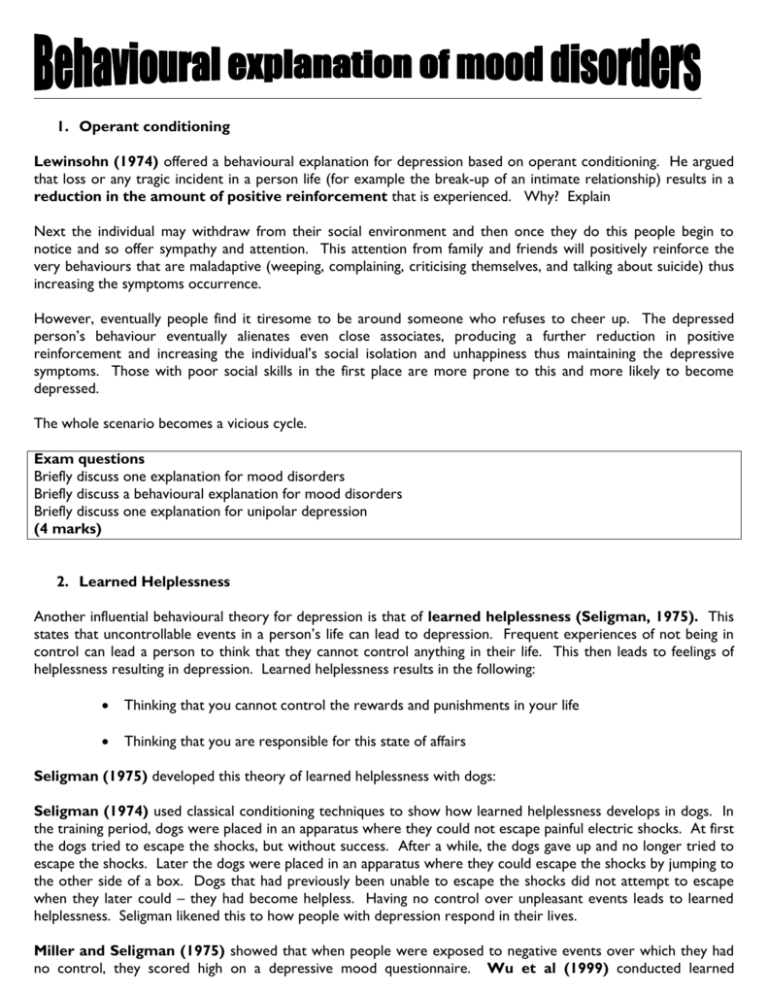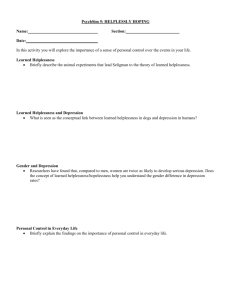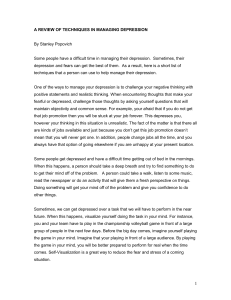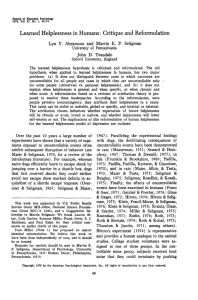Behavioural explanations of Mood disorders
advertisement

1. Operant conditioning Lewinsohn (1974) offered a behavioural explanation for depression based on operant conditioning. He argued that loss or any tragic incident in a person life (for example the break-up of an intimate relationship) results in a reduction in the amount of positive reinforcement that is experienced. Why? Explain Next the individual may withdraw from their social environment and then once they do this people begin to notice and so offer sympathy and attention. This attention from family and friends will positively reinforce the very behaviours that are maladaptive (weeping, complaining, criticising themselves, and talking about suicide) thus increasing the symptoms occurrence. However, eventually people find it tiresome to be around someone who refuses to cheer up. The depressed person’s behaviour eventually alienates even close associates, producing a further reduction in positive reinforcement and increasing the individual’s social isolation and unhappiness thus maintaining the depressive symptoms. Those with poor social skills in the first place are more prone to this and more likely to become depressed. The whole scenario becomes a vicious cycle. Exam questions Briefly discuss one explanation for mood disorders Briefly discuss a behavioural explanation for mood disorders Briefly discuss one explanation for unipolar depression (4 marks) 2. Learned Helplessness Another influential behavioural theory for depression is that of learned helplessness (Seligman, 1975). This states that uncontrollable events in a person’s life can lead to depression. Frequent experiences of not being in control can lead a person to think that they cannot control anything in their life. This then leads to feelings of helplessness resulting in depression. Learned helplessness results in the following: Thinking that you cannot control the rewards and punishments in your life Thinking that you are responsible for this state of affairs Seligman (1975) developed this theory of learned helplessness with dogs: Seligman (1974) used classical conditioning techniques to show how learned helplessness develops in dogs. In the training period, dogs were placed in an apparatus where they could not escape painful electric shocks. At first the dogs tried to escape the shocks, but without success. After a while, the dogs gave up and no longer tried to escape the shocks. Later the dogs were placed in an apparatus where they could escape the shocks by jumping to the other side of a box. Dogs that had previously been unable to escape the shocks did not attempt to escape when they later could – they had become helpless. Having no control over unpleasant events leads to learned helplessness. Seligman likened this to how people with depression respond in their lives. Miller and Seligman (1975) showed that when people were exposed to negative events over which they had no control, they scored high on a depressive mood questionnaire. Wu et al (1999) conducted learned helplessness experiments on rats. They found that levels of serotonin and norepinephrine were lower than in rats that had not gone through a learned helplessness schedule. Exam question Make up three exam questions that could possibly come up which would be based on Learned Helplessness 3. Another explanation that supports how individuals may develop depression as a result of factors in their environment can be seen in the study below: Swann et al (1992) conducted a study to show that depressed people choose to be with others who view them negatively. College students who were depressed and college students who were not depressed were allowed to select a partner to interact with. The students were informed that one potential partner viewed them negatively, another positively and another in a neutral way. Depressed college students showed greater desire to be with a partner where that partner viewed them negatively. By contrast, students who were not depressed preferred to interact with a partner who viewed them positively. Why then do people with depression look to be with people who have depression? There are 3-4 studies mentioned in the notes above – can you think of any actual realistic evaluations of those studies that could be used in an essay for the behavioural explanations of depression? Exam question Describe one study in which a behavioural explanation for depression has been investigated. Indicate why the study was conducted, the method used, results obtained and conclusion drawn. (5 marks) Nb don’t forget to come up with your own evaluation for that 5th mark! General evaluations of the behavioural explanation Read the evaluative comments below then in your own words explain why it is an evaluation in support or against the belief that the behavioural explanation is the most considerable explanation of depression… Observational studies of people with depression have shown that they receive less positive reinforcement than other family members (Lewinsohn et al 1973) Studies such as that by Swann et al proves that …. The success of behavioural therapies including token economy and social skills training (which encourages a client to improve their positive behaviours which in turn are then rewarded - positive reinforcement) supports the idea that lack of positive reinforcement must be the cause. Explain Lack of social reinforcement, in particular, does seem to be very important. Other people do tend to avoid, or be angry, with depressives and they do have fewer friends. Explain It may be that lack of reinforcement is a result of depression, rather than its cause. Explain Although there may initially be secondary gain for the depressed person from concerned friends and carers, the depression often continues long after others have given up showing concern. Explain… Behavioural explanations such as that provided by Seligman have been based on studies with animals/dogs. It could be argued that humans are qualitatively different from animals and so we should not generalise these studies to humans. Explain Those explanations provided by Lewinsohn and Seligman require an understanding of cognitive processes – a problem with the behaviourist view then is that it cannot be used as a pure explanation independently. However the learned helplessness theory was reformulated to ‘attribution helplessness’ as a way of accounting for cognitive factors. Look up… Other explanations such as _____________ may be a better explanation of depression because?.... Other evaluations Seligman’s work used animals and although he did undertake work with human participants, further studies have been unable to replicate his findings. After all – humans use the saying ‘if at first you don’t succeed try, try, try again’. There are also obvious ethical issues involved with these kinds of studies – where both animals and humans have been subjected to stressful situations. Psychological harm must be avoided at all costs – however sometimes the ends justify the means and if they gave consent then we may overlook this problem. Whilst learned helplessness explains how life events cause unipolar depression, it does not really provide an explanation for the mood swings seen in bipolar disorder – i.e. the delusional and hallucinatory behaviours.







